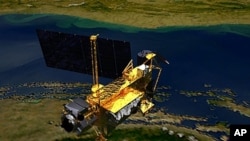A decommissioned, bus-sized satellite known as UARS is plunging back to the Earth, and is expected to reenter the atmosphere on Friday.
The U.S. space agency NASA says the plummeting satellite is expected to reenter Earth's atmosphere "sometime during the afternoon" of Friday, September 23, Eastern Daylight Time.
The Upper Atmosphere Research Satellite's orbit takes it over most of the planet -- all of the continents except Antarctica. NASA says UARS is not expected to hit North America because it will not be passing over the continent Friday afternoon.
That leaves five continents and several oceans as possible strike zones. Scientists say they will be able to refine their predictions as the satellite nears.
Mark Matney, an orbital debris scientist at NASA's Johnson Space Center in Texas, says the likelihood of being struck by a piece of satellite debris is slim.
"If you talk about the probability of you getting hit, it's something like one in trillions, so actually the odds of you getting hit is quite small," said Matney. "So I don't think anybody needs to be unduly concerned about it."
Most of UARS will disintegrate as it reenters Earth's atmosphere. But NASA says 26 "potentially hazardous" parts of the satellite are expected to survive the fiery reentry. Pieces that are expected to hit the planet are made of stainless steel, titanium and beryllium, and include batteries, wheel rims and empty fuel tanks, ranging in mass from .6 to 158 kilograms.
The U.S. Department of Defense routinely tracks more than 22,000 pieces of debris orbiting our planet.
"And about one object per day reenters [Earth's atmosphere], but it's usually a small piece of debris," noted Matney. "Really, something this size - this is six metric tons - reenters about once a year. It just so happens that this is the first time a NASA satellite of this size has reentered in about 30 years."
NASA says it has no confirmed reports of a person ever being injured or property being significantly damaged by reentering space debris.
US Satellite to Reenter Atmosphere Friday









